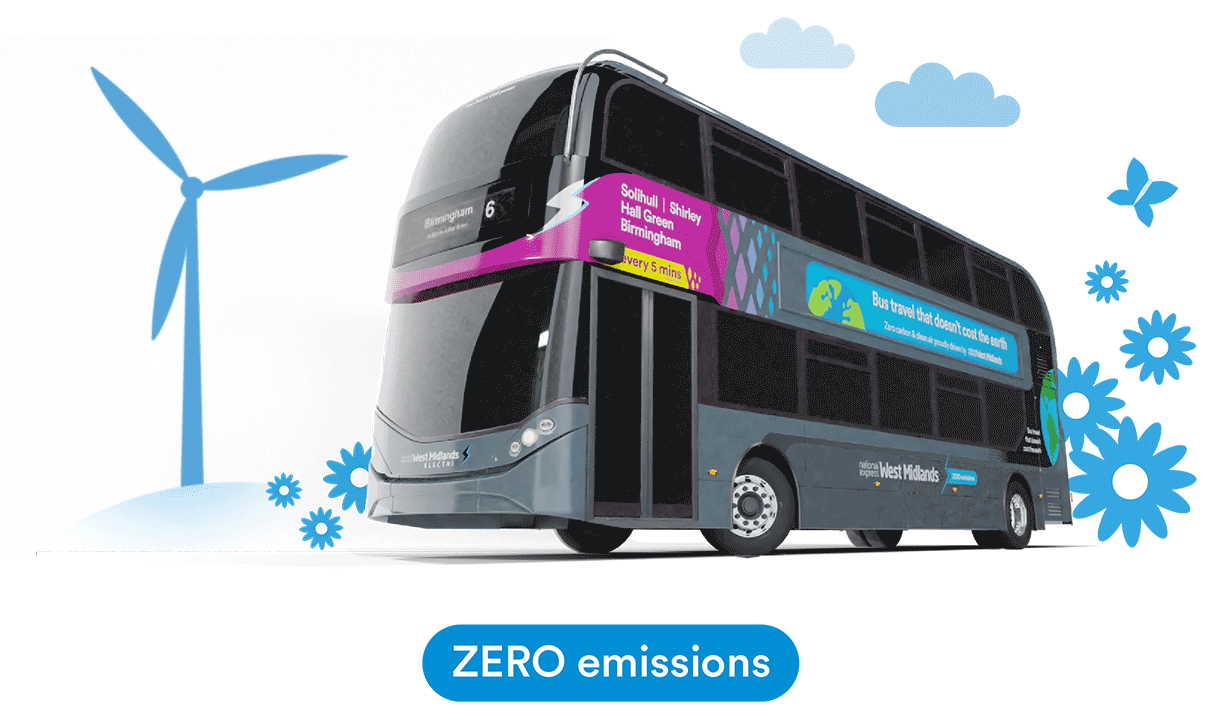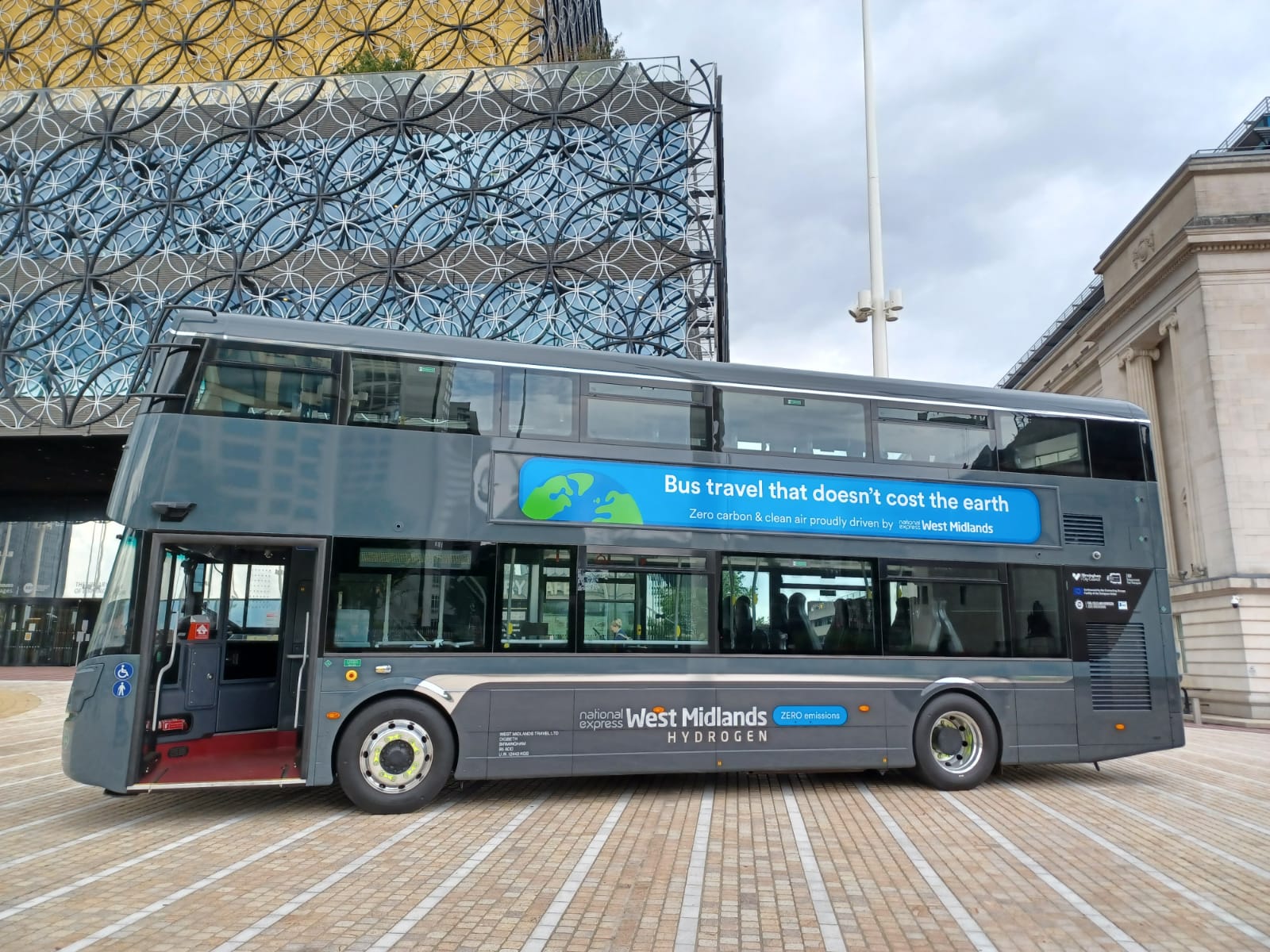
Zero emissions buses
Clean air, zero emissions buses

Zero emissions
Cleaner air
Extra legroom
Comfy seats onboard
USB power
Charge on the go
Stop announcements
So you don't miss your stop
CCTV
For safer travel
 Learn more about our buses
Learn more about our buses
The West Midlands aims to lead the green revolution and become a net zero carbon economy by 2041. We all have a key role to play in making that happen and we have already committed that our UK bus fleet will be fully zero emission much earlier, from 2030. By operating electric and hydrogen double deckers in service, we will learn which routes lend themselves to different bus types and what the mix of vehicles in our fleet should be going forward.
Our electric buses

All about electric
Electric buses
Built in Falkirk by Alexander Dennis, our electric buses have no engine and are battery powered.
Electric virtual bus tour
Is electric better than diesel?
Electric vs diesel
So you are probably thinking, why are electric buses a whole lot better than normal, diesel fuelled buses. Let us explain:
- Our electric vehicles produce zero carbon emissions at the tailpipe and are powered by renewable ‘green’ energy - even the heaters run off the battery!
- Electric buses charge up in four hours, and can run for 220 kilometres in the winter, and 280 kilometres in the summer before needing another charge.
- Along with our hydrogen buses, electric is the next step to upgrading our buses to become fully zero emission from 2030.
Electric bus facts!
Did you know...
- Our drivers have to be specially trained to drive the electric buses because they behave differently to combustion engine-driven buses. The drivers have to learn to preserve the charge for as long as possible and extend the range of the vehicle.
- A shed-sized battery, a charging station for each bus and a new system for engineers to monitor the buses’ performance have been implemented at the garages.
- If you want to know if a bus is electric, look out for the number on the back of the vehicle. We literally reset the clock so the electric buses start from ‘001’ and carry the prefix ‘E’
- An electric bus can seat 25 passengers downstairs and 38 upstairs - so 63 in total. A Platinum but seats 30 downstairs and 43 upstairs - 73 in total. The difference is partly due to bus design layout (they are different models made by different bus manufacturers) but also partly because in an electric bus you need more room for battery cells to power it.
- An electric bus weighs almost 2 tonnes heavier than a standard diesel bus.
- In the first 12 months our 29 electric buses clocked over 850.000 miles and saved 1400 tonnes of carbon dioxide going out into the atmosphere.
Our hydrogen buses

All about hydrogen
Hydrogen buses
Made by Wrightbus in Northern Ireland, each double-decker includes six Kevlar-coated aluminium tanks which store the hydrogen to fuel the driving of the bus (rather than a tank full of diesel!)
The bus can be refuelled within 10 minutes and the hydrogen is used when the buses fuel cell battery (yup, they run on electricity too!) capacity falls to 80%.
Since December 2021, National Express West Midlands has been operating Birmingham City Council's 20 hydrogen buses on the 51 route from Birmingham to Walsall via Perry Barr.
UK hydrogen roadshow
Is Hydrogen better than diesel?
Hydrogen vs diesel
So you are probably thinking, why are hydrogen buses a whole lot better than normal-diesel fuelled buses? Let us explain:
- The by-product will no longer resemble toxic diesel fumes - but will be water.
- Wrightbus say it's hydrogen bus models are expected to have a 15-year service life at least, which is a great initiative to cleaner and greener air for the future.
- Hydrogen is part of the next step to upgrading our bus fleet to become fully zero emission from 2030, along with our electric buses. Here’s to cleaner air and greener emissions!
-
They emit water vapour, meaning no carbon dioxide or other harmful gases are being pumped into the air.
Hydrogen bus facts!
Did you know...
- A hydrogen bus can seat 25 passengers downstairs and 38 upstairs - so 63 in total. A Platinum but seats 30 downstairs and 43 upstairs - 73 in total. The difference is partly due to bus design layout (they are different models made by different bus manufacturers) but also partly because in an electric or hydrogen bus you have to fit in enough battery cells to drive it.
- H2 (which is the scientific name for hydrogen) does not emit a sound once it starts moving.
- The hydrogen used to fuel our new buses will be sourced locally from Tyseley Energy Park.
- The top speed of the H2 bus is 50mph, pretty impressive for a gas fuelled bus eh!
- Birmingham City Council has unveiled the first of its 20 new hydrogen buses
- The daily distance that each hydrogen bus will travel is initially set at 300km, from launch day. This is the same strategy we launched with our electric buses, as it gives us a learning period to adjust the daily scheduled distance if needed.
Our National Express group vision is to become the UK’s most sustainable bus and coach company and our electric and hydrogen buses get us another step closer...
Like us on Facebook
See what we're up to, what's going on locally and get the latest service updates.
Like us on Facebook
Follow us on X
The best place to see the latest West Midlands travel updates while on the go.
Follow us on XGet inspired on Instagram
See local sights and tag us in your bus pictures. Follow us to get involved!
Follow our InstagramBack to top











